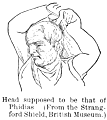Phidias
(Φειδίας). The greatest sculptor and statuary of Greece. Of his personal history we possess but few details. He was a native of Athens, was the son of Charmides, and was born about the time of the battle of Marathon, B.C. 490. He began to work as a statuary about 464, and one of his first great works was the statue of Athené Promachos, which may be assigned to about 460. This work must have established his reputation; but it was surpassed by the splendid productions of his own hand, and of others working under his direction, during the administration of Pericles. That statesman not only chose Phidias to execute the principal statues which were to be set up, but gave him the oversight of all the works of art which were to be erected. Of these works the chief were the Propylaea (q. v.) of the Acropolis, and, above all, the temple of Athené on the Acropolis, called the Parthenon, on which, as the central point of the Athenian polity and religion, the highest efforts of the best of artists were employed. There can be no doubt that the sculptured ornaments of this temple, the remains of which form one of the glories of the British Museum (see Elgin Marbles), were executed under the immediate superintendence of Phidias; but the colossal statue of the divinity made of ivory and gold, which was enclosed within that magnificent shrine, was the work of the artist's own hand. The statue was dedicated in 438. Having finished his great work at Athens, he went to Elis and Olympia, which he was now invited to adorn. He was there engaged for about four or five years from 437 to 434 or 433, during which time he finished his statue of the Olympian Zeus, the greatest of all his works. On his return to Athens he fell a victim to the jealousy against his great patron, Pericles, which was then at its height. The party opposed to Pericles, thinking him too powerful to be overthrown by a direct attack, aimed at him in the persons of his most cherished friends—Phidias, Anaxagoras, and Aspasia. (See Pericles.) Phidias was first accused of peculation; but this charge was at once refuted, as, by the advice of Pericles, the gold had been affixed to the statue of Athené in such a manner that it could be removed and the weight of it examined. The accusers then charged Phidias with impiety, in having introduced into the battle of the Amazons, on the shield of the goddess, his own likeness and that of Pericles. On this latter charge Phidias was thrown into prison, where he died from disease, in 432. Of the numerous works executed by Phidias for the Athenians the most celebrated was the statue of Athené in the Parthenon, to which refer |
| Head supposed to be that of Phidias. (From the Strangford Shield, British Museum.) |
“Thus while God spake, ambrosial fragrance fill'd
All heaven, and in the blessed spirits elect
Sense of new joy ineffable diffused.” The statue was removed by the emperor Theodosius I. to Constantinople, where it was destroyed by a fire in A.D. 475. In 1888 a red vase was exhumed at Tanagra, bearing a signature which archæologists believe to be that of Phidias. The distinguishing character of the art of Phidias was ideal sublimity, especially in the representation of divinities and of subjects connected with their worship. While on the one hand he freed himself from the stiff and unnatural forms which, by a sort of religious precedent, had fettered his predecessors of the archaic or hieratic school, he never, on the other hand, descended to the exact imitation of any human model, however beautiful; he never represented that distorted action, or expressed that vehement passion, which lie beyond the limits of repose; nor did he ever approach to that almost meretricious grace, by which some of his greatest followers, if they did not corrupt the art themselves, gave the occasion for its corruption in the hands of their less gifted and spiritual imitators. See Murray, Greek Sculpture (London, 1880); Waldstein, The Art of Pheidias (Cambridge, 1885); Collignon, Phidias (Paris, 1886); and the article Statuaria Ars.




